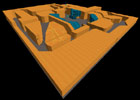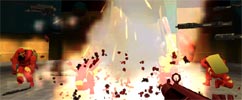

deathjam : julian oliver
- brief -
deathjam
is a modification of the Half-life gaming engine.
it incorporates 32 artifically intelligent IBOT's
that navigate, hunt and kill each other in an environment built especially
for this purpose.
Using the especially designed 'IDIOT / SAVANT' camera console the user
can
point at a bot and share it's gaze as it is hunted by it's clones. At
any time, whether dead or alive, the user can find another host, become
the hunter or the killer. Indifferent to the presence of a witness, the
bots will persist in their work - we can check up on their progress from
the comfort of our homes by logging into a gaming server setup especially
for our interest.
It's here that we find a facility for the complex - the deathjam exists purely
to provide the user with a means to surf the point of death. Neither keeper
or subject, the witness of the deathjam, witnesses death and dying as an opensource.


- download -
none
yet
- notes -
so far we've only run deathjam five times - i shouldn't have given them grenade launchers, and they need more evasive reponses to the threat of death to keep the spawn cycles less frequent.
- appearances -
online only
Beyond the industrialisation of death in the D-Day Landings and beyond the fetishistic refrains of cinema, deathjam is the absolute 'transport' of the sign 'to kill'. Eclipsing the narratological, empathic, and the strategic, deathjam priveledges the position of the spectator as a transubstantiated subject and witness of the death event. The artificially intelligent agents of the deathjam provide a detached relation to the mortal bind - we are free to switch to any other body at any time, though no body, nor death is any more significant than the next.
After death each bot spawns immediately and at the point from which they have always spawned. The iterations and flows of each spawn cumulatively organise the operations of future spawns. This gradual tempering or consolidation of action within the conditions of their predicament will be the only data from which we might draw a morphology - the spawn times become faster - much faster than we can organise, accellerating death into a purely serial and rhythmical array.
Deathjam is designed as a kind of laboratory, where we might explore a transubstantiated mortality.
Sickened or exhilirated, the Deathjam exists to provide opporunity to investigate the phenomenon of the 'virtual death', and engage with a significant cultural transformation; where the 'experience' of death itself is being actively commodified.
The
simulation of death in the first person is a curiously intense focus of advanced
computational systems. Both generative
and diagrammatic the deathjam draws critical attention to the transformation
of death through it's 're-embodiment' in the avatarial subject of networked
3D game.
Deathjam asks, 'what is left of death when it iself becomes virtual?
